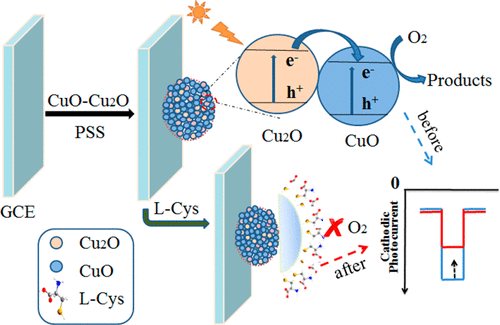当前位置:
X-MOL 学术
›
ACS Appl. Mater. Interfaces
›
论文详情
Our official English website, www.x-mol.net, welcomes your
feedback! (Note: you will need to create a separate account there.)
One-Step Synthesis of CuO–Cu2O Heterojunction by Flame Spray Pyrolysis for Cathodic Photoelectrochemical Sensing of l-Cysteine
ACS Applied Materials & Interfaces ( IF 8.3 ) Pub Date : 2017-11-13 00:00:00 , DOI: 10.1021/acsami.7b13020 Yuhan Zhu 1 , Zuwei Xu 2 , Kai Yan 1 , Haibo Zhao 2 , Jingdong Zhang 1
ACS Applied Materials & Interfaces ( IF 8.3 ) Pub Date : 2017-11-13 00:00:00 , DOI: 10.1021/acsami.7b13020 Yuhan Zhu 1 , Zuwei Xu 2 , Kai Yan 1 , Haibo Zhao 2 , Jingdong Zhang 1
Affiliation

|
CuO–Cu2O heterojunction was synthesized via a one-step flame spray pyrolysis (FSP) process and employed as photoactive material in construction of a photoelectrochemical (PEC) sensing device. The surface analysis showed that CuO–Cu2O nanocomposites in the size less than 10 nm were formed and uniformly distributed on the electrode surface. Under visible light irradiation, the CuO–Cu2O-coated electrode exhibited admirable cathodic photocurrent response, owing to the favorable property of the CuO–Cu2O heterojunction such as strong absorption in the visible region and effective separation of photogenerated electron–hole pairs. On the basis of the interaction of l-cysteine (l-Cys) with Cu-containing compounds via the formation of Cu–S bond, the CuO–Cu2O was proposed as a PEC sensor for l-Cys detection. A declined photocurrent response of CuO–Cu2O to addition of l-Cys was observed. Influence factors including CuO–Cu2O concentration, coating amount of CuO–Cu2O, and applied bias potential on the PEC response toward l-Cys were optimized. Under optimum conditions, the photocurrent of the proposed sensor was linearly declined with increasing the concentration of l-Cys from 0.2 to 10 μM, with a detection limit (3S/N) of 0.05 μM. Moreover, this PEC sensor displayed high selectivity, reproducibility, and stability. The potential applicability of the proposed PEC sensor was assessed in human urine samples.
中文翻译:

半胱氨酸阴极光电化学传感的火焰喷雾热解一步合成CuO–Cu 2 O异质结
CuO–Cu 2 O异质结是通过一步火焰喷雾热解(FSP)工艺合成的,并用作光敏材料,用于构建光电化学(PEC)传感装置。表面分析表明,形成了尺寸小于10 nm的CuO–Cu 2 O纳米复合材料,并均匀分布在电极表面。在可见光照射下,由于CuO-Cu 2 O异质结的良好特性,例如在可见光区域的强吸收和有效分离光生电子-空穴对,CuO-Cu 2 O涂层电极表现出令人钦佩的阴极光电流响应。在l-半胱氨酸(l-Cys)通过形成Cu–S键与含Cu的化合物结合,建议将CuO–Cu 2 O用作检测1- Cys的PEC传感器。观察到CuO–Cu 2 O添加l -Cys的光电流响应下降。影响因素,包括CuO的铜2 ö浓度,CuO系Cu被覆量2 O,并在朝向PEC响应施加的偏置电位升-Cys进行了优化。在最佳条件下,建议的传感器的光电流随着l浓度的增加而线性下降。-Cys从0.2到10μM,检测极限(3S / N)为0.05μM。此外,该PEC传感器显示出高选择性,可重复性和稳定性。拟议的PEC传感器在人尿液样品中的潜在适用性进行了评估。
更新日期:2017-11-14
中文翻译:

半胱氨酸阴极光电化学传感的火焰喷雾热解一步合成CuO–Cu 2 O异质结
CuO–Cu 2 O异质结是通过一步火焰喷雾热解(FSP)工艺合成的,并用作光敏材料,用于构建光电化学(PEC)传感装置。表面分析表明,形成了尺寸小于10 nm的CuO–Cu 2 O纳米复合材料,并均匀分布在电极表面。在可见光照射下,由于CuO-Cu 2 O异质结的良好特性,例如在可见光区域的强吸收和有效分离光生电子-空穴对,CuO-Cu 2 O涂层电极表现出令人钦佩的阴极光电流响应。在l-半胱氨酸(l-Cys)通过形成Cu–S键与含Cu的化合物结合,建议将CuO–Cu 2 O用作检测1- Cys的PEC传感器。观察到CuO–Cu 2 O添加l -Cys的光电流响应下降。影响因素,包括CuO的铜2 ö浓度,CuO系Cu被覆量2 O,并在朝向PEC响应施加的偏置电位升-Cys进行了优化。在最佳条件下,建议的传感器的光电流随着l浓度的增加而线性下降。-Cys从0.2到10μM,检测极限(3S / N)为0.05μM。此外,该PEC传感器显示出高选择性,可重复性和稳定性。拟议的PEC传感器在人尿液样品中的潜在适用性进行了评估。

































 京公网安备 11010802027423号
京公网安备 11010802027423号